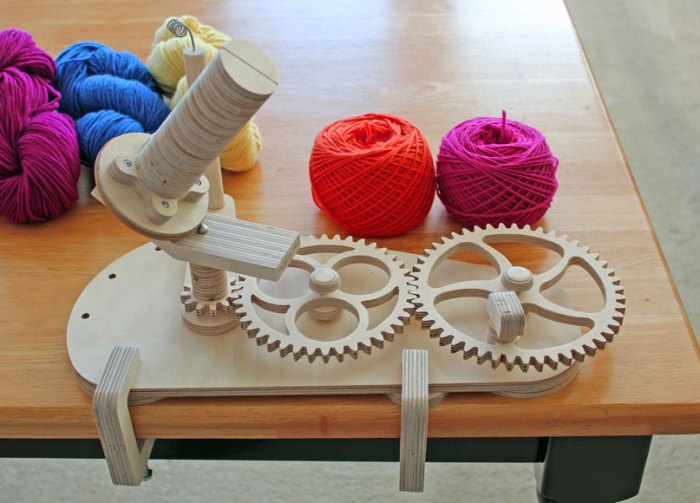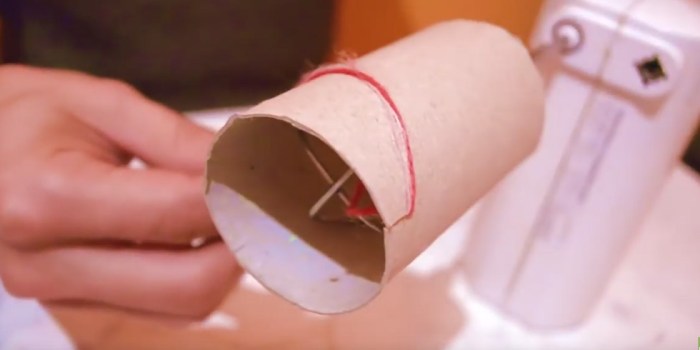DIY yarn winders offer a creative and cost-effective way to manage your yarn stash. Whether you’re a seasoned knitter or just starting out, a homemade yarn winder can be a valuable tool for organizing your yarn and making the winding process smoother. This article will guide you through the process of building your own yarn winder, from choosing materials to tackling advanced designs.
We’ll explore the different types of yarn winders available, delve into the essential materials and tools needed for construction, and provide step-by-step instructions for both basic and more intricate designs. We’ll also address common troubleshooting issues and share tips for maintaining your DIY yarn winder, ensuring it remains functional and reliable.
Introduction to DIY Yarn Winders

A yarn winder is a tool used to wind yarn into a neat and organized ball or cake, making it easier to work with and preventing tangles. They come in various sizes and styles, catering to different yarn weights and project needs.
Creating a DIY yarn winder can be a fun and rewarding project, allowing you to customize it to your specific requirements and preferences. It’s a great way to save money and unleash your creativity.
Types of Yarn Winders
DIY yarn winders can be broadly classified into two main types: manual and electric.
- Manual yarn winders are operated by hand, requiring you to turn a crank or handle to wind the yarn. They are typically more affordable and compact, making them ideal for smaller projects or those who prefer a hands-on approach.
- Electric yarn winders are powered by electricity, automating the winding process. They are faster and more efficient, particularly for larger projects or those with limited time. They also offer more control over the tension and winding pattern.
Examples of DIY Yarn Winder Projects
The internet is brimming with creative and innovative DIY yarn winder projects. Here are some examples:
- A simple manual yarn winder can be made using readily available materials like a cardboard tube, a wooden dowel, and a few screws. This project is perfect for beginners and requires minimal tools and effort.
- A more advanced DIY yarn winder can be built using a repurposed CD player, a motor, and a few electronic components. This project offers more control over the winding speed and tension, making it suitable for larger projects.
- For a truly unique and personalized yarn winder, consider using salvaged wood, metal, or other materials to create a custom design. This project allows you to showcase your creativity and craftsmanship.
Basic Construction Techniques

Building a DIY yarn winder doesn’t require extensive woodworking skills or specialized tools. With a few basic materials and some patience, you can create a functional and reliable winder for your yarn projects.
This section provides a step-by-step guide to construct a simple DIY yarn winder, covering various methods for attaching the winding mechanism to the base and offering tips for ensuring sturdiness and functionality.
Choosing Materials
Selecting the right materials is crucial for building a durable and functional yarn winder.
- Base: The base provides stability and support for the winder. Consider using a sturdy piece of wood, such as plywood or MDF, for a stable base. Alternatively, you can use a circular piece of wood, like a cutting board, for a more compact design.
- Winding Mechanism: The winding mechanism consists of a spindle that rotates to wind the yarn. You can use a dowel rod or a sturdy metal rod for the spindle. The spindle should be long enough to accommodate the length of your yarn skeins.
- Braces and Supports: Braces and supports are essential for maintaining the structure and stability of the winder. Use wood scraps, metal rods, or even sturdy cardboard for these components.
- Fasteners: Securely attach the various components using screws, nails, or glue. Choose fasteners appropriate for the materials you’re using.
Assembling the Winding Mechanism
The winding mechanism is the heart of the yarn winder, responsible for smoothly winding the yarn onto the spindle.
- Spindle: The spindle is the rotating component that winds the yarn. You can use a dowel rod, a sturdy metal rod, or even a wooden spool. Ensure the spindle is long enough to accommodate the length of your yarn skeins.
- Bearing: A bearing helps the spindle rotate smoothly. You can use a simple metal washer or a specialized bearing for smoother rotation. The bearing should be securely attached to the base or a support structure.
- Handle: A handle allows you to easily rotate the spindle. You can attach a handle to the spindle using a screw or a clamp. The handle should be comfortable to grip and allow for smooth rotation.
Attaching the Winding Mechanism to the Base
Several methods can be used to attach the winding mechanism to the base.
- Direct Mounting: This method involves directly attaching the winding mechanism to the base using screws or nails. Ensure the screws are long enough to securely fasten the mechanism to the base.
- Bracket Attachment: You can create a bracket using wood or metal to support the winding mechanism. The bracket is then attached to the base, providing a more stable and adjustable attachment point.
- Pivot Mechanism: A pivot mechanism allows the winding mechanism to rotate freely while remaining attached to the base. This can be achieved using a metal rod or a wooden dowel as a pivot point.
Ensuring Sturdiness and Functionality, Diy yarn winder
To ensure your yarn winder is sturdy and functional, consider these tips:
- Stability: The base should be wide and heavy enough to prevent the winder from tipping over during use. You can increase stability by adding weight to the base or using a larger, sturdier base material.
- Smooth Rotation: The spindle should rotate smoothly without any resistance or jamming. Ensure the bearing is securely attached and the spindle is properly lubricated.
- Tension Control: A functional yarn winder should allow you to adjust the tension of the yarn as it’s being wound. You can achieve this by using a tensioning mechanism, such as a spring or a weight, or by adjusting the pressure on the spindle.
With a little creativity and effort, you can build a DIY yarn winder that meets your specific needs and adds a personal touch to your crafting space. From simple designs to more complex creations, the possibilities are endless. So, gather your materials, unleash your inner maker, and embark on your own DIY yarn winder journey!
A DIY yarn winder is a great way to keep your yarn organized and tangle-free. You can find plenty of tutorials online for building your own, using simple materials like cardboard tubes and dowels. If you’re looking for a more rustic look, you could even try repurposing old pallets for the project, similar to the creative ways people use pallets to create DIY pallet walls.
No matter your style, a homemade yarn winder is a practical and fun project that will help you keep your knitting and crocheting projects running smoothly.
